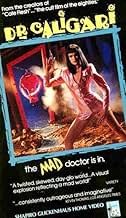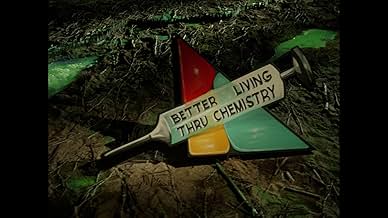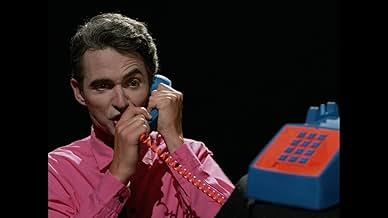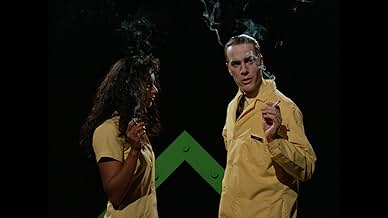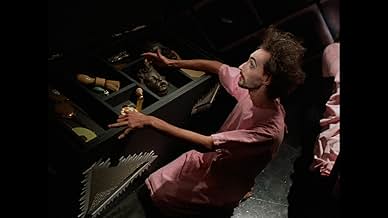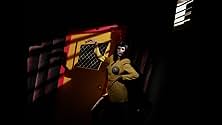CALIFICACIÓN DE IMDb
6.0/10
1.8 k
TU CALIFICACIÓN
La nieta de un infame médico experimenta con terapias hormonales y de choque en su manicomio.La nieta de un infame médico experimenta con terapias hormonales y de choque en su manicomio.La nieta de un infame médico experimenta con terapias hormonales y de choque en su manicomio.
- Dirección
- Guionistas
- Elenco
Debra De Liso
- Grace Butler
- (as Debra Deliso)
Nina DePonca
- Human Lamp
- (as Vera Butler)
Salvador Espinoza
- Spanish Patient
- (as Salvador R. Espinoza)
- …
- Dirección
- Guionistas
- Todo el elenco y el equipo
- Producción, taquilla y más en IMDbPro
Opiniones destacadas
I first saw this movie when I was about 14. I didn't really get it. It was definitely...different. Anyway, years later I had help from Mr.Leary's friend and finally figured out what it was about. It's about screwing with your head and making you enjoy it. Great impressionist sets and lighting. Truly bizarre acting and dialogue. Sometimes someone will just pop out of the bottom of the frame, say something and then drop back out of frame. The days of enhancing my viewing experiences are over, but I carry many fond memories of this film with me. Good luck finding a copy...a used one is your best bet.
This is unquestionably a WTF film. One of those strange films that seem made precisely to test the viewer's resistance to absurdity.
Loosely inspired by Robert Wiene's 1920 classic, takes from it, in addition to the name, a vague inspiration in the expressionist sets of the time and the surrealist theme.
With bright, plasticized colors, and an eroticism worthy of a Rocky Horror Picture Show, it misses, however, the music, the main attraction of the cult gay musical from the seventies. Here, we have some very eighties electronic sounds, which do nothing to help a weak and totally absurd script.
However, there remains a visual richness, in the sets, in the wardrobe, even in the surreal exaggeration with which some characters are embodied.
For some it will be enough to make a cult film. For me, however, it is complete nonsense and a waste of time.
It's better to see Rocky Horror Picture Show again, it's much more fun and above all, it has a memorable soundtrack and characters.
Loosely inspired by Robert Wiene's 1920 classic, takes from it, in addition to the name, a vague inspiration in the expressionist sets of the time and the surrealist theme.
With bright, plasticized colors, and an eroticism worthy of a Rocky Horror Picture Show, it misses, however, the music, the main attraction of the cult gay musical from the seventies. Here, we have some very eighties electronic sounds, which do nothing to help a weak and totally absurd script.
However, there remains a visual richness, in the sets, in the wardrobe, even in the surreal exaggeration with which some characters are embodied.
For some it will be enough to make a cult film. For me, however, it is complete nonsense and a waste of time.
It's better to see Rocky Horror Picture Show again, it's much more fun and above all, it has a memorable soundtrack and characters.
Stephen Sayadian's "Dr. Caligari" (1989) is a phantasmagorical fever dream that plunges viewers into a world more disconcerting and distorted than the distorted sets of its silent film inspiration, "The Cabinet of Dr. Caligari". This film is a testament to the enduring power of German Expressionism, a perverse pastiche of its visual and psychological hallmarks warped through a lens of '80s cult cinema sensibilities.
At the heart of this bizarre spectacle is the asylum of Dr. Caligari's granddaughter, a cold and clinical space saturated with lurid neon colors reminiscent of a warped Dick Tracy comic panel. Here, sexual deviance is not merely a pathology but the very subject of experimentation. The film's psychosexual explorations are brazen and exploitative, channeling a dark, camp energy that borders on the parodic.
Sayadian uses dialogue as a weapon of disorientation. Characters deliver absurdist, stilted lines with unnerving artificiality, their words less meaningful utterances than sonic textures adding to the film's unsettling atmosphere. This mockery of 'arty' pretension contributes to the film's blackly comedic tone, as does the gleeful revelry in its own exploitation.
While some might admire its visual boldness and thematic provocations, "Dr. Caligari" is undeniably a film of extremes. Its blend of jarring style, sexual explicitness, and absurdist humor isn't crafted for a broad audience. Those with stomachs for the bizarre, a taste for the transgressive, and a fondness for the stylistic legacy of German Expressionism will find this film an intoxicating, if deeply flawed, curiosity. It's a warped mirror reflecting both the anxieties and guilty pleasures of its era, a fever dream of psychosexual perversion that remains both repellent and oddly compelling.
At the heart of this bizarre spectacle is the asylum of Dr. Caligari's granddaughter, a cold and clinical space saturated with lurid neon colors reminiscent of a warped Dick Tracy comic panel. Here, sexual deviance is not merely a pathology but the very subject of experimentation. The film's psychosexual explorations are brazen and exploitative, channeling a dark, camp energy that borders on the parodic.
Sayadian uses dialogue as a weapon of disorientation. Characters deliver absurdist, stilted lines with unnerving artificiality, their words less meaningful utterances than sonic textures adding to the film's unsettling atmosphere. This mockery of 'arty' pretension contributes to the film's blackly comedic tone, as does the gleeful revelry in its own exploitation.
While some might admire its visual boldness and thematic provocations, "Dr. Caligari" is undeniably a film of extremes. Its blend of jarring style, sexual explicitness, and absurdist humor isn't crafted for a broad audience. Those with stomachs for the bizarre, a taste for the transgressive, and a fondness for the stylistic legacy of German Expressionism will find this film an intoxicating, if deeply flawed, curiosity. It's a warped mirror reflecting both the anxieties and guilty pleasures of its era, a fever dream of psychosexual perversion that remains both repellent and oddly compelling.
If there was ever an art-house film that existed, this would be it. In other reviews I've discussed the forays into artistic film-making made possible by the Expressionist movement of the 1920's. I've always thought of the 1980's as a decade that served as a revival in its own right, experimenting with abstract and surrealist qualities upon several mediums. Dr. Caligari serves as a possible end of this decade and the experimentation found within. I can discuss topics like New Romanticism from the 80's a bit more in depth but for some of you that might be as interesting as watching water boil.
This film borrows loosely from the original, and I do mean loosely. For one, Caligari is a woman – and hey, change is good – but why is she a sexual deviant? Two, there is mention of an insane asylum much like the 1920 version as well – but that's it. Everything is strewn about in a convoluted, nightmarish heap. Mrs. Van Houten suffers from extreme nymphomania and her husband, Les, seeks possible treatment at the hands of Dr. Caligari. After this small plot detail is established it's basically a free-for-all. There is symbolism portrayed at every turn. You can't make heads or tails of the dialog. Sexual content is found throughout, even more so than violence. The man responsible for the makeup of this film later went on to do the Pirates of the Caribbean trilogy - what an impressive resume he must have! Sexual gratuity wasn't innovative by 1989, but that isn't what makes this film visually comparative to the 1920 silent version.
This film was not shot in black and white, but the stark difference in contrasting colors and lighting techniques are more than similar to the Expressionist output 70 years earlier. This may have served as a point of brilliance had it not been for the sexual ridiculousness that followed. Literally, and I mean literally, everything in this film deals with sex on some level. I really have no idea why they decided to go down that avenue with a film like this – a name which held importance and value in cinema itself! I suppose it's no shock that the director of this version has been responsible for other "artsy" porn films as well, but why on Earth would you choose to dabble with Dr. Caligari? I wasn't offended by the topics explored – just mystified. Was that really the goal here? To take something that held value and make it laughable?
As with all films of this caliber, it has a considerable cult following. If you're an art house fan that doesn't mind trashy, exploitative themes of violence and sexual content, this may be your lucky day. Make no mistake; aside from visual similarities, The Cabinet of Dr. Caligari and Dr. Caligari are two very different films.
This film borrows loosely from the original, and I do mean loosely. For one, Caligari is a woman – and hey, change is good – but why is she a sexual deviant? Two, there is mention of an insane asylum much like the 1920 version as well – but that's it. Everything is strewn about in a convoluted, nightmarish heap. Mrs. Van Houten suffers from extreme nymphomania and her husband, Les, seeks possible treatment at the hands of Dr. Caligari. After this small plot detail is established it's basically a free-for-all. There is symbolism portrayed at every turn. You can't make heads or tails of the dialog. Sexual content is found throughout, even more so than violence. The man responsible for the makeup of this film later went on to do the Pirates of the Caribbean trilogy - what an impressive resume he must have! Sexual gratuity wasn't innovative by 1989, but that isn't what makes this film visually comparative to the 1920 silent version.
This film was not shot in black and white, but the stark difference in contrasting colors and lighting techniques are more than similar to the Expressionist output 70 years earlier. This may have served as a point of brilliance had it not been for the sexual ridiculousness that followed. Literally, and I mean literally, everything in this film deals with sex on some level. I really have no idea why they decided to go down that avenue with a film like this – a name which held importance and value in cinema itself! I suppose it's no shock that the director of this version has been responsible for other "artsy" porn films as well, but why on Earth would you choose to dabble with Dr. Caligari? I wasn't offended by the topics explored – just mystified. Was that really the goal here? To take something that held value and make it laughable?
As with all films of this caliber, it has a considerable cult following. If you're an art house fan that doesn't mind trashy, exploitative themes of violence and sexual content, this may be your lucky day. Make no mistake; aside from visual similarities, The Cabinet of Dr. Caligari and Dr. Caligari are two very different films.
This is definitely one of the strangest alt-indie-freak films I have seen. The characters are almost caricatures, but their actions are choreographed with their lines as they pose around each other.
Madeline Reynard is electrifying as Dr. Caligari, a descendant of the infamous Caligari. She is working on an insidious plot to transfer personality traits between patients in a mental hospital by swapping brain fluids. Her plans go awry when some staff members catch on and she uses a cannibalistic masochist (Shivver Boy) in her experiments.
I definitely recommend this movie for your collection, if not to scare your "normal" friends but for the giant latex tongue.
Madeline Reynard is electrifying as Dr. Caligari, a descendant of the infamous Caligari. She is working on an insidious plot to transfer personality traits between patients in a mental hospital by swapping brain fluids. Her plans go awry when some staff members catch on and she uses a cannibalistic masochist (Shivver Boy) in her experiments.
I definitely recommend this movie for your collection, if not to scare your "normal" friends but for the giant latex tongue.
¿Sabías que…?
- TriviaFinal film of Fox Harris.
- ConexionesFeatures El gabinete del Dr. Caligari (1920)
Selecciones populares
Inicia sesión para calificar y agrega a la lista de videos para obtener recomendaciones personalizadas
- How long is Dr. Caligari?Con tecnología de Alexa
Detalles
- Tiempo de ejecución1 hora 20 minutos
- Color
- Mezcla de sonido
- Relación de aspecto
- 1.66 : 1
Contribuir a esta página
Sugiere una edición o agrega el contenido que falta

Principales brechas de datos
What is the French language plot outline for Dr. Caligari (1989)?
Responda

